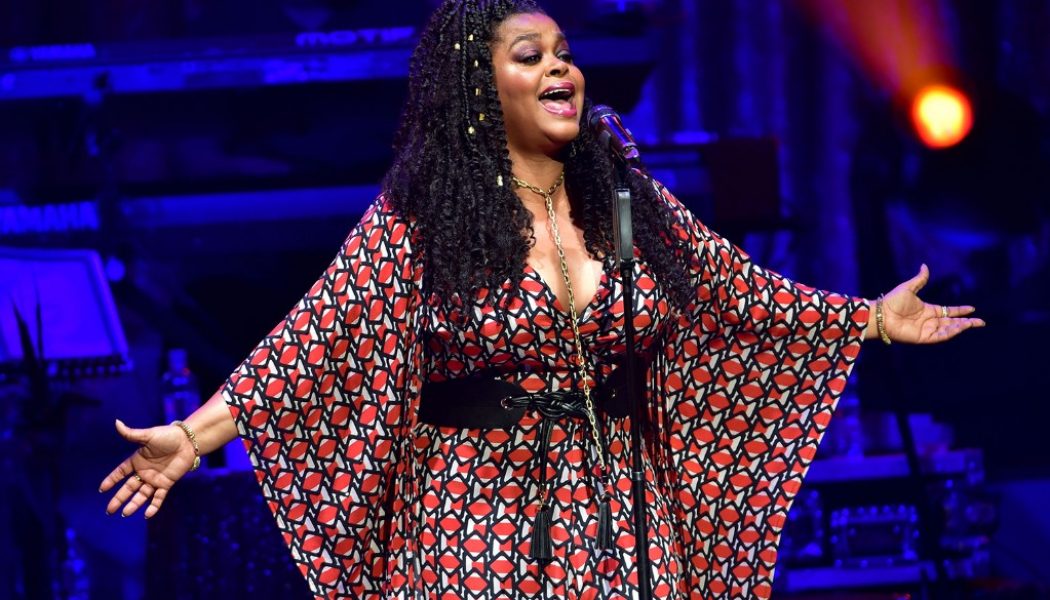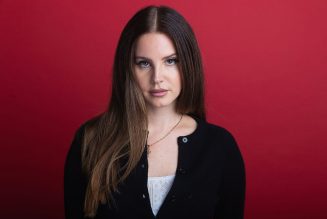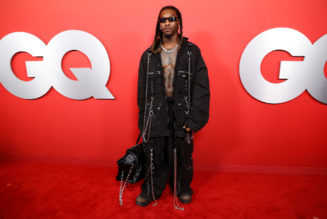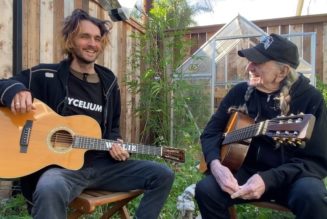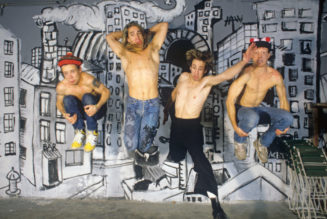
Live, streaming or otherwise, the classic album still reveals the beautiful totality of a Black woman in love with love, 20 years later.
There is love that is patient and kind. Then there is love that entangles itself in your essence, demanding either rapturous consummation or defiant release. Even more significant, there is love that when you encounter it in person, it is a spiritual force of nature. It makes you “want to go home and f—.” Who Is Jill Scott? Words and Sounds Vol. 1 — the two-decade-old debut album from “Jilly from Philly” — effortlessly walks the line between these three previously mentioned types of love.
Valentine’s Day 2020 found Ms. Scott at the Maryland Live! Casino, in the suburbs between Washington, DC, and Baltimore, Md. There was no more ideal time to celebrate and highlight this album’s legacy. Like the artist who created it, Who Is Jill Scott? is human, honest, and unforgettable. With its anniversary on July 18, Scott celebrated the momentous occasion (earlier in the year) with a series of concerts performing the album in its entirety, from beginning to end.
Playing Who Is Jill Scott? from beginning to end has moments that are reminiscent of Philadelphia’s R&B tradition. “A Long Walk” was released in January 2001 and hit the top 10 of Billboard’s Hot R&B/Hip-Hop Songs charts. It has a jazzy, mature, and timelessly familiar vibe that feels like an inclusive mix of everyone, male and female, who recorded a lovestruck ballad in the city from ”Me and Mrs. Jones” vocalist Billy Paul in 1972 to The Roots’ Black Thought performing “Silent Treatment” in 1995. Moreover, Jill’s live performance blends soul music’s relatability with the magical confluence of Afro-spirituality and visceral, directly-impacting sex appeal that gives a sentient insurgence to Scott’s lyrics. Thus, Scott’s contralto on these songs, in a cavernous room, is intensely warm and inviting.
On “Honey Molasses” and “He Loves Me (Lyzel in E Flat),” the live keyboards feel a little hotter than they do on the recording. The raw sexuality in Scott’s voice both attracts and attacks. If Scott’s voice heard on record alone birthed a generation of millennials, seeing that voice, embodied and enlivened, is a joyously unique experience.
Just like Jill Scott, the person, Who Is Jill Scott? has matured. Jill’s classic material is spiritually emboldened from wisdom gained via living a life where the words she’s singing actually informed the actions of the life she lived. Scott’s live performance of the late ‘90s album feels worn in and comfortable. The songs don’t sound exactly like the album anymore.
Hearing Jill sing “The Way,” it’s a singalong as a shared experience that Jill initially voiced for a generation of women both young and old. The cadence of “toast, two scrambled eggs, grits” is elongated in such a way to not as much welcome in the voices of the largely female crowd of 5,000 strong. Rather, in it being Jill pausing, then “toast…two scrambled eggs. (Pause, comically elongated pause…Jill smiles, the crowd murmurs, laughs, whoops, then hollers in a throaty, seductive tone implying that the actions of the previous night that preceded the following morning’s breakfast were pleasurable)…GRIIIITS,” it’s a call-and-response, Black Pentecostal Church of Sex and Soul Food, moment.
“I’ve been performing this album for 20 years, and it’s only just now that I realize that it’s sequenced like a movie,” Jill Scott notes during a jovial afternoon conversation. “It’s a heavy album, where I’m the main character, that requires me to click in and out of these unbelievably intense emotions. This album is filled with songs that are meant to be seen, tasted and touched. It covers everything from feeling light and bubbly to being pensive and sad. But it’s the love thread throughout that unites it all.”
Carvin Haggins — one of the album’s six primary producers — echoes this notion. He says that on [Who Is Jill Scott?], Jill “was a woman telling stories that every woman knows, but is afraid to tell. It identifies with women going through those stories as specific gateways of life heading towards adulthood.”
For instance, to hear the go-go-influenced single “It’s Love” is always a powerful funk moment. But to experience the song sung by Scott — as she wears a multicolored kimono decorated with a bedazzled rendering of her face in the middle of her back, while African tribal dancers enhance the moment on the stage’s background screen — you hear a whole other manner of expression as Scott becomes a wise griot awakening the Orishas. These stories set free and inspire the audience — especially women — to simultaneously navigate love and their Black humanity.
Soul music’s maturation into welcoming the fullness of what Neo-soul has become is a fascinating journey. Before the release of Who Is Jill Scott?, there was a stronger fusion between R&B and hip-hop defining crossover pop’s acceptance of Neo-soul and less slickly-produced and sample-driven music. The gap was closing at the top of Billboard’s 1998 year-end charts. In that year, Soul’s traditional essence was the domain of Brandy and Monica, whose lovelorn teenybopper crush battle anthem “The Boy Is Mine” spent one-third of the year in Billboard’s top 10, finishing at No. 2 of the Hot 100 overall singles of the year. Soul’s New Jack lust — as represented by “Too Close,” Next‘s homage to getting an erection on the dancefloor — was America’s number one single for five weeks after spending an entire year on Billboard’s Hot 100 chart. It was the No. 1 song of the year.
One year later, Jill Scott was recording her debut album in Philadelphia. In the camps of care-filled love and cocksure hip-hop passion had yet to meld her full sound. Jill Scott’s experimental performances on Who Is Jill Scott? allowed for a more significant pop expansion of how Neo-soul synergized these divergent energies. This success did not happen without the aid of an impressive collection of musical superstars whose accomplishments precede them.
Who Is Steve McKeever?
Steve McKeever was a Harvard-educated entertainment lawyer, talent manager and record executive. He’d worked with Berry Gordy at Motown Records from 1991-1996, specializing in jazz and soul music with MoJAZZ, Motown’s jazz imprint. Plus, he was instrumental in the sale of the label to Polygram Records in 1993. “By 1998, I was working on developing Hidden Beach Recordings, and Michael Jordan was our lead investor, so we had to put together the label in secret. Sony, our distributor, was expecting more jazz-type projects, but I knew that the original label pitch was to do things more left and right of the mainstream.”
Neo-soul was emerging as a genre but had yet to take root in modern rhythm and blues. D’Angelo‘s 1995 album Brown Sugar and Maxwell‘s 1996 debut album Urban Hang Suite opened a door. Erykah Badu‘s 1997 Baduizm and a year later, Lauryn Hill‘s Miseducation of Lauryn Hill followed after that. Jill Scott was emerging as a Philadelphia-based cultural creative.
Her “Words and Sounds” spoken word and song event was gaining in popularity, as was the regular Black Lily showcase for female poets, emcees and vocalists. She also was an understudy for the Collins Canadian touring company for the musical Rent between December 1997-November 1998. Scott’s popularity put her on the radar of The Roots, who had her write the Badu-performed hook on their 1999 hit “You Got Me.” However, Scott did perform the track live with The Roots on some domestic and overseas tour dates in the same year.
“I lied to Questlove and told him that I wrote songs,” Scott jokes while reminiscing. “He came to one of my poetry readings, and I said, ‘Yeeeah, yes I do, I…I write songs all of the time!’”
McKeever had been told of Scott’s talents, so he set off to the city of Brotherly Love to hear her perform. Scott delivered a spoken word, rap and soul vocal improvisational showcase for 45 straight minutes in front of the Hidden Beach chief and a crowd of musicians. He remembers fondly, “Jill extemporaneously sang and spoke her entire life story. It was unbelievable. It was like watching Sarah Vaughan, Ella Fitzgerald, and Biggie performing at the same time. It was jazz meets rap meets soul meets spoken word.”
[embedded content]
The Making of Who Is Jill Scott?
By the late 1990s, A Touch of Jazz studios, founded by Jeff “DJ Jazzy Jeff” Townes, had become a hub for the “neo-soul” community of the Mid-Atlantic region. Conscious, underground rappers like Washington, D.C. based Kev Brown, and his Low Budget crew and The Roots, plus soul artists like Kenny Lattimore, had connections there. Impressively, over a decade at A Touch of Jazz, Townes incubated and developed producers and musicians that worked on albums for the likes of Lauryn Hill, Erykah Badu, Common, D’Angelo, Nuyorican Soul, Anita Baker, Floetry, Musiq Soulchild, Bilal, Dwele and Raheem Devaughn.
“Jazzy Jeff and I are both friends with a woman named Kim Mitchell [the mother of Jeff’s youngest son, Amir Mitchell-Townes],” Scott told KCRW disc jockey Garth Trinidad in a 1999 interview. “She told Jeff I needed to be at A Touch of Jazz as a writer. I had only written ‘A Long Walk.’ When I visited the studio, I sat down with the producers, and I sang it. They said, on the spot, ‘You’re an artist!’ I already knew that!”
Yet, the artist in her knew that dues needed to be paid. “I noticed that the walls in the lobby of A Touch of Jazz were carved with very intricate designs, but they hadn’t been stained or polyurethaned,” Scott recalls during our phone conversation. “I asked Jazzy Jeff if I could do that for him. He allowed me to do that. That gave me the ability to be in and around the studio more, and try to get into the booth to record. I almost died polyurethaning that room; it had no ventilation! But I’d just be in there humming and singing, waiting for the chance to stick my head into the room…when I did that, that’s when ‘A Long Walk’ happened.”
Along with Haggins, A Touch of Jazz hired five other producers — Vidal Davis, Andre Harris, Ivan Barias, Keith Pelzer, and Darren “Limitless” Henson — to work on Scotts’ debut album in 1999. “Jazzy Jeff taught us how to encapsulate the emotional vibe of the history of soul music,” says Haggins. “As well, we were also all childhood friends who didn’t do things the conventional way. We didn’t know how to produce. We had original ideas and concepts that we combined with what Jeff was teaching us. Three guys were from the church and wanted the tracks to sound smooth, like what you’d play at a service. Three guys were hip-hop heads who wanted the beats to sound hard, like what you’re playing in a Jeep. Jill’s album became a guinea pig for these sounds we were trying to combine to make.”
A creative scene that ultimately birthed an era of superstar moments for music’s millennial era had humble roots. “Philly was so fun and free back then. I like to call it a ‘spooky punch.'” Scott’s voice swells with excitement when discussing the emerging music scene in the City of Brotherly Love around the turn of the 21st century. “Nobody was checking for us, so the music was exceptionally pure. Kindred the Family Soul, the Jazzyfatnastees, Musiq Soulchild was around. Scott Storch would be playing the piano while Bilal was lying on the floor in Questlove’s old apartment; it was an incredibly creative time. We were creating for creation’s sake.”
“We didn’t know what the industry was doing,” Haggins says. “A Touch of Jazz was in the basement of an office building. We came in, we ate together, played together, stayed grounded and to ourselves.” At a time wherein the first wave of what would later be known as neo-soul had established itself as top 40 charting, Black radio favorites, Haggins and crew remained nonplussed and focused. “We never thought too much about the Billboard charts. All we knew is that if we all loved something in the studio, that’s the only way we knew it was good.”
To wit, Scott adds on the recording of her debut album that “the chemistry of writing the album at A Touch of Jazz was effortless. I loved it. There are six cats down there. Each one plays their instruments, and they can get down! They’re young; they travel, they work. They’re into jazz, the blues, gospel, funk, they feel the music.”
When asked about her musicality in 1999, Jill Scott jokes, “My mom was playing some good stuff and reading to me when I was in the womb!” She continues, “Once I was born, I do remember hearing a lot of Donny Hathaway, Stevie Wonder, Michael Jackson and Etta James around the house. That was my Sunday house-cleaning music.” Combine those influences with the Nina Simone, Billie Holiday, Ella Fitzgerald, Sarah Vaughan and Notorious B.I.G. that McKeever heard during Scott’s live audition, and a formidable blend develops. Mining that essence into 18 magical tracks requires a unique strategy to achieve artistic synergy between Scott and her producers.
“[Who Is Jill Scott?] is music created without apprehension,” Haggins opines. “So the main goal of our work was to make sure that we played well, but not get in the way of Jill’s creative force. As producers, we painted around her creative foundation. The honesty of the lyrical content had to shine through. That’s the greatest strength of the album. Jill’s lyrics are creating three-to-five minute movies that we’re soundtracking. It works perfectly.”
Haggins’ strategy was an unabashed success, as Scott notes to KCRW in a 1999 interview. “There’s space in how [Who Is Jill Scott?] was made. As an artist, I’m open; I like to feel the music, I’m free. I sing like I’m an emcee, even sometimes. This album makes you feel like you want to put your fist up in the air and say, yeah!”
The notion that Jill’s basically a singing emcee has validity. Rap’s fingerprints are all over the album. The Joe Williams and the Jazz Orchestra sample that underpins Kool G Rap & DJ Polo‘s 1992 hit “Ill Street Blues” appears in the deep cut “Brotha,” adding a sonic heft to the ode to supporting Black men. As well, “Gettin’ In The Way” is a master class in the craft of how a break and cadence can influence the feel of a song. Because of a drum, it’s much less a post-heartbreak ballad and much more a sing-song battle rap diss of a woman attempting to interrupt her relationship. It owes as much in vocal cadence to Biggie’s 1999 single “Dead Wrong” as it does Aretha Franklin’s 1968 hit “Think.”
[embedded content]
On “Dead Wrong,” Biggie’s flow is aided by a sample of the drum break from Al Green‘s “I’m So Glad You’re Mine.” It’s a metronomic smack that’s as thick in impact as it is broad in resonance. Biggie’s laconic flow slumps over and around it, creating its unique funk-as-vibe. Davis’ drums on Scott’s “Gettin’ in the Way” are similarly thick as they are broad, allowing her warnings of violence to reside in a Biggie-similar funk. Seeing Scott playfully remove her earrings and add in some colorful words for added emphasis during her 2020 live edition at Maryland Live! bears truth to this impact.
“Yup! I’ve been trying to go for MC of the Year for 20 years! I’m about to fight in that song,” Scott says. “While working with the musicians, the sound and the energy of the music put the words on the tip of my tongue. The music told me that story. All I had to do was ride the beat.”
Since her debut album, Jill’s catalog stirs deep passions in listeners worldwide. Scott herself has also been known to simulate oral sex on stage with a microphone while performing her material. Related, “He Loves Me (Lyzel in E Flat)” was described in a 2016 Revolt article as inspiring “a love felt ‘in every way imaginable,’ from hair follicle to toenails. It starts in a coo, transitions into spoken word, and ends in what sounds like a full-on tribal cry.”
On the making of “Lyzel,” Haggins relates a story that showcases the sacred and secular collision that makes the album special. “[Producer/arranger] Keith Pelzer was playing at his father’s church at choir rehearsal when he came up with the chords for ‘Lyzel.’ He played it for Jill (who told KCRW that she felt like she was “taken someplace by it”); it stuck. Even if you’re playing in church, you’re also a young man experiencing life, and the church is working in you too, so that’s what you get sometimes.”
“He came up with that in church?!? Wow!!” Jill Scott reacts with pure shock when I tell her where Pelzer developed the chord progressions underpinning the song. “Those chords are so spiritual,” Scott says. “The tone of my voice is really pure. I’m not doing a lot [tonally]. The vibe comes from a pure, childlike, even God-like place. Even more, 20 years later, it’s when I sing it live, and the crowd sings with me, in my style. Note for note, it’s amazing.” The effortless nature of the creative energy behind the album is uniquely memorable. “I walked in, and he was playing it. I grabbed my pen and started writing on the spot. That’s how a lot of this album happened. I’d walk in the room, hear what the guys were playing, and have an idea. We completed seven songs in the summer of 1999 like that.”
[embedded content]
Upon receiving Scott’s album, mastering engineer Herb Powers Jr. was both flummoxed and impressed. “When I first heard it, I thought, ‘This album is bigger than soul music. It feels like these are rap records that have bass lines bigger than house music records!'” By 2000, Powers already had 25 years of experience and was a Philadelphia icon, having worked with the likes of disco progenitor Philadelphia International Records. He also put the finishing touches on a series of quintessential New York hits including house and breakout rap singles like Loose Joints’ “Is It All Over My Face?” and Afrika Bambaataa‘s “Planet Rock.” He also went on to hone the New Jack Swing genre’s vibe via Teddy Riley and Keith Sweat‘s works. As the engineer of note at The Hit Factory, Powers’ work was key in developing Bad Boy’s crossover era of success, including Notorious B.I.G. albums and Sean “Puffy” Combs’ own No Way Out in 1997.
Powers continues, “When I was mastering [Who Is Jill Scott?], I kept going back and forth on if it sounded too heavy? Her voice is so big, yet so smooth. It partially occupies the bottom end. But there’s still room for so much to occupy the top end of those tracks. The strings, the keyboards, everything. Neo-soul is hard and heavy like rap, but spacious like gospel and R&B. That’s what makes it such a unique genre.” Ultimately, he pays it the highest of compliments. “Whenever I enter a room where I need to test the acoustics, Who Is Jill Scott? is a go-to record that I play. The sonics on it are perfect. Jill’s voice, the instruments, everything. It’s timeless.”
Epilogue
At the end of her live performance on Valentine’s Day night — while receiving her third standing ovation in 90 minutes — Scott said, “There were many people who did not believe this album would be successful. Some people hated my hair, my body, there was even a radio executive who said, ‘How is this pork chop eating [woman] ever going to sell records?'” Overwhelmed by the crowd’s effusive praise, she smiled while slightly sweaty and visibly exhausted. Revealing this little known career moment gave each person in the crowd something personal of Scott’s to take with them, forever.
“I cried so much when this album first came out. I didn’t think it would connect with anyone,” Scott remembers. “Then it sold 8,000 copies. I couldn’t believe 8,000 people bought my album. Then it hit 16,000, 32,000 — every week the number of sales doubled. Then they tripled. When I found out the album had gone gold, I had one question: ‘What does that mean?! HALF A MILLION?!’ I couldn’t believe it.”
When asked about the moment when he knew that creative gold had been struck with Who Is Jill Scott?, Haggins remembers being in Los Angeles in early 2001 for the Grammy Awards. “They had a billboard on Sunset Boulevard that said, ‘Who Is Jill Scott? Over a million people know.’ That was a real ‘wow’ moment. I couldn’t believe that this album we’d created was so popular.” When asked about the album’s platinum-selling success, McKeever remembers, “Sony (Hidden Beach’s parent label) thought that Jill’s album would sell, say 22,000 copies, maximum. That would have been considered a success.”
“My career is based on a stew of hip-hop, R&B and jazz,” Scott says, after pausing to let an ultimate declaration about her career resonate. “It’s a good ole wholesome stew, and it’ll help you grow.” Who Is Jill Scott? being one of the ultimate showcases of how much someone loves Black love and Black music allowed it to foster Scott’s stardom. Its legacy, similar to Scott’s career, is based on growth. One woman’s words and sounds evolved into gospel hymn-like recitations repeated in concert halls 20 years after they were created. That’s different and special, in every way imaginable. Quite simply, like any stew we consume, that comes from kind hands and an honest heart, it’s love.
This article originally appeared on VIBE.
